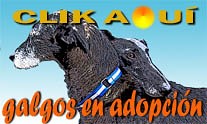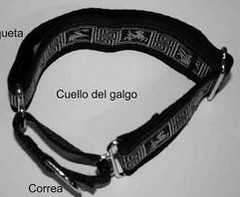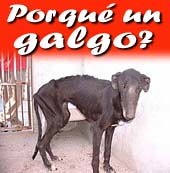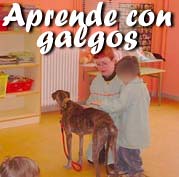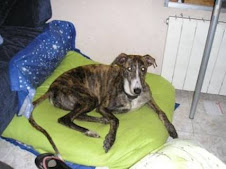
CÓMO COLOCAR NUESTROS COLLARES:
Los collares de los que disponemos a veces se envían abiertos al máximo, por lo que puede ocasionar alguna confusión a la hora de colocarlos. Para que ésto no suceda, os adjuntamos una foto de cómo se tienen que colocar.
Como algunas personas nos han preguntado cómo colocarlo. Os adjuntamos una foto de cómo se tienen que colocar.
Fijaos bien en la siguiente foto: El collar tiene que ser doble. Es decir, que la parte que le toca al cuello tiene que haber dibujo igual que en el exterior. Si por el contrario está la etiqueta es que está mal. No ha de quedar ninguna anilla que está suelta... si es así, está mal porque no hace su función.
Esperamos que os sirva de ayuda.


Actualmente disponemos de una amplia gama de modelos de collares para vuestros galgos u otras razas.
Pódeis verlos en nuestro blog:
http://galgomania.blogspot.com/2009/08/nuevos-modelos-de-collares-martingale.html
COLLAR Y CORREA:
GALGOS:
El collar:es recomendable que sea un collar especial para galgos, anti-escape (Martingale, o de doble anilla). No han de quedar holgados, porque se les puede salir por la cabeza, debido a la especial estructura ósea del galgo. (Tienen la cabeza más estrecha que los otros perros).
Recomendamos que sea reflectante para aumentar la seguridad de noche.
Puedes encotrar collares martingale en: http://collaresmartingale.blogspot.com/

Para que el collar de tu perro quede bien ajustado, la mejor manera es que al ponerlo pase perfectamente por cabeza y orejas, pero para sacarlo tengas que pasar primero una oreja y luego la otra, ya que si pasan las dos orejas ala vez no está suficientemente ajustado, luego una vez puesto que el collar pueda girar (que no le vaya apretar demasiado).

-Cuando viajan en coche, incluso en trayectos cortos, deben ir seguros (con cinturón de seguridad para perros, red...) abriremos la puerta del coche un poco lo suficiente para entrar y ataremos la correa al collar del perro antes de quitarle el arnés de coche y debemos asegurarnos que antes de subir han hecho sus necesidades.


-Recomendamos que lleven siempre una chapita identificativa con 2 teléfonos del propietario en el reverso. de donde cogemos el collar, porque se corre La chapa se debe colocar en cualquier parte del collar, excepto en la argolla el riesgo de enganchar el mosquetón de la correa en la argolla de la chapa, en vez de en la argolla del collar. (Es preferible llevar dos collares, uno al que vaya sujeta la correa y otro más estrecho, mejor fijo o martingale estrecho que lleve sólo la placa identificativa, para que vaya identificado en caso de rotura o pérdida del otro.
Es muy importante que el perro lleve su chapita identificativa, con sus datos, los más importante, son los teléfonos de contacto de los propietarios. ES MUY IMPORTANTE, PORQUE SI SE EXTRAVíA, LO PRIMERO QUE HARÁ LA PERSONA QUE LO ENCUENTRE ES MIRAR SI LA LLEVA, Y SI ES ASÍ OS PODRÁ LLAMAR RÁPIDAMENTE.
-No recomendamos el uso de correa Flexi, extensible, ya que es muy fácil que ante un tirón del perro se suelte de la mano y el ruido que hace cuando cae a suelo y al arrastrarla, puede producir una ataque de pánico en el perro, y tener nefastas consecuencias.
-La correa debe ser semi larga y resistente, nos gustan las semilargas, que hagan aproximandamente 2,5 cmde ancho y 1,20 cm de largo.

-En el caso excepcional de que un perro tire mucho, salte, o sea escapista, se le puede poner doble collar, collar de cuello y arnés o petral, personalmente en estos casos, uso la correa de adiestramiento, Halti, que es muy cómoda porque es blanda y acolchada, además no quema si tiran, tiene dos mosquetones que permiten, con usa sola correa, llevar el perro cogido al mismo tiempo por el collar y el arnés.
La correa de adiestramiento permite ponerla en bandolera o puedes atarla a la cintura.

-Los cubos de fregar y cubos con detergente han de estar fuera de su alcance.
Una costumbre saludable para tu perro, es tirar el agua de los cubos de fregar inmediatamente después de usarlos, (llevan detergentes y productos químicos nocivos). La mayoría proviene de situaciones de abandono. Gente de la calle y de las protectoras tienen la costumbre de llenarlos de agua para que beban, lo que puede confundir al perro, beber de ellos y poner en peligro su salud.
-Cubos de la basura cerrados o fuera de su alcance. Personalmente uso unos que cierran con imán, y no se pueden abrir fácilmente. Como la gran mayoría ha estado abandonados, y han sobrevivido comiendo lo que han encontrado, tienen una naturaleza ladrona, y sienten atracción por las basuras, pero también aprenden muy rápido, con varios no firmes, son suficientes.
-No dejar bolsas de plástico a su alcance. A veces son tentadoras, porque huelen a comida y si las ingiere, son nuy peligrosas para la salud del perro.
-No dejar periódicos en el suelo. Hay que tener en cuenta que la tinta es tóxica y si los come, puede causarle la muerte. (Una familia decidieron ausentarse un fin de semana y como no tenían con quien dejar su Dogo (Dogo alemán) y no querían llevarlo a la residencia. Lo dejaron en casa, con toda la casa llena de periódicos por el suelo, el perro al verse tantas horas solo, tuvo un ataque de ansiedad, y le dio por comer los periódicos. Desgraciadamente no se pudo hacer nada por él, murió envenenado.
-No deje a su perro suelto, sólo en zonas para perros, pipicans seguros, con la altura de la valla adecuada.
Galgos: Es recomendable que valla sea de dos metros o superior. Hay uno que está muy bien en Vilanova i la Geltrú, Barcelona.
-Puede viajar en Catalunya con su perro en trenes de cercanías y Ferrocarriles de la Generalitat, pero han de ir atados con correa y bozal.
-Galgos: Son un poco ladronzuelos, sobre todo al principio, por eso es aconsejable no dejar comida a su alcance. (Debido a la historia de abandono que han sufrido la mayoría, que se ha tenido que despabilar para poderse llevar algo a la boca)
-No debe jugar con zapatos o la ropa personal, ya que si le da por ej: una zapatilla para que se entretenga, él pensara que está permitido jugar con los zapatos y un día podría romper ese par de zapatos que nos acabamos de comprar.
OTHER SUGGESTIONS TO CONSIDER:
-Cleaning buckets should be kept out of reach. A good habit is to tip thewater immediatley after use. (It usually has chemical products in it) Themajority of galgos come from abandoned situations. In some cases the publicand shelters use buckets to put water in for them to drink from. Somethingyour galgo could easily be confused over, drink from and put his life indanger.
-Rubbish bins, - kept closed and out of reach.Personally I use ones whichclose with magnetic closeures and can't be opened easily. When so many havebeen abandoned, and learnt to survive by eating whatever they can find, theytherefore are natuarl scavengers. They are attracted to bins, however a fewfirm No's is all it takes, as they are quick learners.
- Don't leave plastic bags around. At times they are tempted to look insidebecause they smell of food, if they inhale or swallow them, again verydangerous for the health of your galgo.
- Don't leave newspapers on the floor. The ink is toxic and if they chew it- it can cause death. (A family decided to go away for the weekend, theydidn't have anyone to leave their Great Dane with; they chose to leave himalone and NOT take him to a canine residency. So they filled the housewithnewspaper.
Naturally hours left alone he had an anxiety attack, he ate the paper andsadly there was nothing anyone could do - he died by being poisoned.)
- Water and food bowls. The best bowls are stainless steel that can beraised to the height of your dog, they're easily cleaned and don't break.They must be washed everyday. Keeping the water seperated from the foodbowl. By eating from a bowl raised to the height of the dog, it preventscolic, this being more common in the larger breeds.
-Don't let your galgo of the lead. Only in areas made for your dog. ie Dogparks which are safe, with the fencing at a suitable height they can't getout from.GALGOS: It is recommended fencing should be 2 metres or higher. There's onewhich is very well done in Vilanova i la Getru Barcelona.
-In Catalunya you can travel with your dog on trains and local trains, butthey must be on the lead and be muzzled.
-GALGOS: They are scavengers, mainly in the beginning, for this purpose itis adviseable not to leave food at their level. (This trait comes from ahistory of having been abandoned by which the majority have suffered. It hasbeen essential they "become this way" so they can grab something in theirmouth quickly to baable to eat.
-They musn't play with shoes or clothes. If for example you give him a shoeto entertain him, he'll think its ok to play with any shoes; or break a pairof shoes that have just been bought. He would not beable to understand thedifferance.









